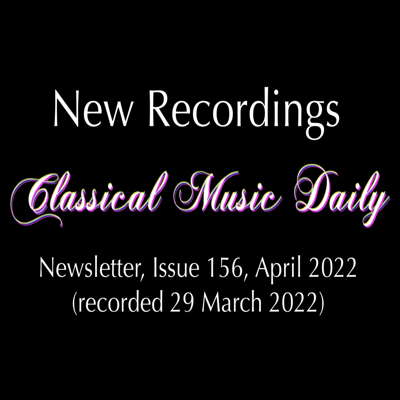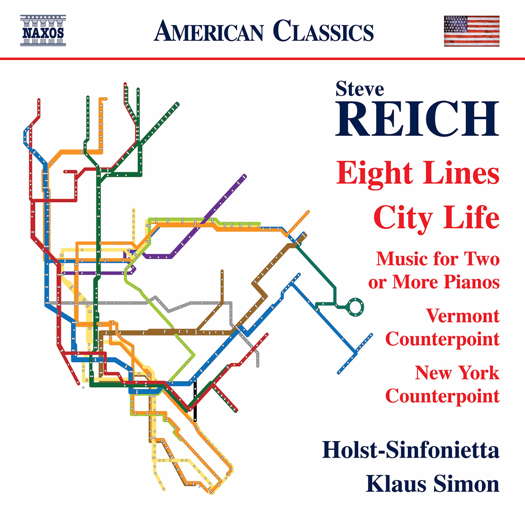- The Porcupine's Quill
- Schnittke
- Ava June
- William Blitheman
- Sándor Balassa
- Paul Nilon
- Herbert Blomstedt
- Lancastria
 VIDEO PODCAST: New Recordings - Find out about Adrian Williams, Andriy Lehki, African Pianism, Heinrich Schütz and Walter Arlen, and meet Stephen Sutton of Divine Art Recordings, conductor Kenneth Woods, composer Graham Williams and others.
VIDEO PODCAST: New Recordings - Find out about Adrian Williams, Andriy Lehki, African Pianism, Heinrich Schütz and Walter Arlen, and meet Stephen Sutton of Divine Art Recordings, conductor Kenneth Woods, composer Graham Williams and others.
ARTICLES BEING VIEWED NOW:
- Régine Crespin
- Marián Varga
- Hector Berlioz
- Profile. A Very Positive Conductor - Paul Bodine talks to Los Angeles Opera's Music Director Designate, Domingo Hindoyan
- Ruth Railton

Reich through German Eyes and Ears
GIUSEPPE PENNISI listens to a Steve Reich anthology
'... a very dramatic reading with a small number of instrumentalists ...'
This Naxos recording in the 'American Classics' series provides a good opportunity for your reviewer to listen to an anthology of Steve Reich's music as read through German eyes and ears. This happens to be just a few weeks after I listened to (and reviewed) live performances of Reich's works as read through Italian eyes and ears at the Chigiana International Festival and Summer Academy in Siena - read the 8 and 30 July 2021 features in this magazine. Only one but the most important piece on the CD - City Life - was among the compositions I reviewed at the Siena Festival.
I think that Reich is one the major American composers of the last fifty years. He is considered a classic, rightly, and his music is played not only in the United States but worldwide. He is known mainly for his contribution to the development of minimalism in the mid to late 1960s. Reich's work is marked by its use of repetitive figures, slow harmonic rhythm and canons. His compositional style reflects his explicit rejection of classical traditions, serialism and indeterminacy because, unlike these styles and traditions, he sought to create music in which the compositional process was discernible within the music itself. Reich describes this concept in his book Music as a Gradual Process, stating: 'I am interested in perceptible processes. I want to be able to hear the process happening throughout the sounding music'. To do so, his music employs the technique of phase shifting, in which a phrase is slightly altered over time, in a flow that is clearly perceptible to the listener. Reich's work took on a darker character in the 1980s with the introduction of historical themes as well as themes from his Jewish heritage, notably in Different Trains (1988).
Reich's style of composition has influenced many contemporary composers and groups. Writing in The Guardian, music critic Andrew Clements suggested that Reich is one of 'a handful of living composers who can legitimately claim to have altered the direction of musical history'. At the Siena Festival, this could be clearly perceived because some twenty different Reich compositions were played. On this CD, two major compositions - Eight Lines (1979/1983) and City Life (1995) are included with some less known but very important works such as Music for Two or More Pianos (1964), Vermont Counterpoint (1982) and New York Counterpoint (1985).
A general comment: the CD provides a good overview of Reich's work, especially of his gradual refinement of phase shifting and of the skilled blend between instrumental music and live electronics. The five pieces taken together are a love song to New York and its way of life.
Music for Two or More Pianos represents a period in the composer's early development in which the various musical concepts that exerted influence on his style begin to intersect with each other, as well as with Reich's own emerging and persistent sense of harmonic clarity. On the CD, one can easily read the influences of jazz as well as a certain notational and performative freedom. The performers are free to move from chord to chord at any time and circle through the whole series of nine chords as many times as desired. Likewise, the performers are free to break up the chord into single notes, figures, or arpeggios, and to render their chosen realizations of the chord notes in any rhythmic scheme they choose. However, all players involved are instructed to move from one chord to the next at the same time so that when one chooses to proceed, the other must likewise move on to the same chord. The Holst-Sinfonietta plays the piece with two pianists - Klaus Simon and Jörg Schweinbenz - and the emphasis is on references to jazz more than, eg, serial music, of which there is a slight reminiscence.
Listen — Steve Reich: Music for Two or More Pianos
(track 1, 4:05-5:04) ℗ 2020 Naxos Rights US Inc :
The two counterpoint pieces – dedicated, respectively, to Vermont (track 3) and to New York (track 4) - are very interesting because of the use of flutes - Anne Parisot and Delphine Roche (Vermont) and clarinets (Andrea Nagy) as well as tape. Both consist of three movements to be played, however, without a pause. This is a clear indication that Reich was composing chamber music but thinking of a larger ensemble.
Listen — Steve Reich: Vermont Counterpoint
(track 3, 0:00-0:54) ℗ 2020 Naxos Rights US Inc :
Eight Lines, composed well before the two counterpoint pieces, is for an ensemble, even though a small ensemble: its original title was Octet. It was a commission from Radio Frankfurt and completed in April 1979. Reich rescored it in 1983. The CD uses the original score and orchestration. Klaus Simon conducts the ensemble and plays one of the pianos. Reich himself said that 'whether there are eight, nine, or ten performers, the piece is always musically an octet'. In 1985, New York City Ballet's balletmaster Jerome Robbins made an eponymous ballet to this music. On the CD, I found that the structure but not the sound of Jewish cantillation influenced the composition, particularly of the flute and piccolo melodies. The work is in five sections. The first and third share a similar texture of rapid piano, cello, and bass clarinet figures, while the second and fourth sections are marked by sustained tones in the cello. The fifth and final section combines these materials. The divisions between sections, however, involve smooth transitions with some overlapping in the parts.
Listen — Steve Reich: Eight Lines
(track 2, 16:11-17:10) ℗ 2020 Naxos Rights US Inc :
City Life tells about a changing New York in five movements, lasting about twenty-five minutes. It tells of the revival of the town after the 1993 bombing of the World Trade Centre, a terrorist event less serious, and less lethal, than that of 11 September 2001 but that, nonetheless, shook New York. The Holst-Sinfonietta plays the original score for a small ensemble conducted by Klaus Simon. Reich himself recommends that all instruments be amplified. In Siena, City Life was performed by a very large complex with several orchestral groups and live electronics with emphasis on digital samples that play back a wide variety of sounds and speech samples, mainly recorded by Reich himself in and around his home in New York City. These sounds include car horns, air brakes, car alarms and many other sounds associated with the city. The use of the samplers extends the idea of using everyday sounds in music, indebted to the taxi horn in Gershwin's An American in Paris. The samplers are loaded with speech and other common sounds from a busy city - car horns, door slams, air brakes, subway chimes, pile drivers, car alarms, heartbeats, boat horns, buoys and sirens. The last movement uses bits of field communications from the New York Fire Department during the 1993 bombing of the World Trade Centre. There are also fragments of speech, some of which have their 'speech melody' performed by the other instruments.
Listen — Steve Reich: Heavy smoke (City Life)
(track 11, 0:47-1:47) ℗ 2020 Naxos Rights US Inc :
The main difference between the CD reading and that of the Siena Festival is that the Holst-Sinfonietta provides a very dramatic reading with a small number of instrumentalists, whereas in Siena the reading was more descriptive of the life and sounds of New York - two legitimate but quite different interpretations.
Copyright © 2 September 2021
Giuseppe Pennisi,
Rome, Italy

CD INFORMATION - STEVE REICH: EIGHT LINES; CITY LIFE
MORE ARTICLES ABOUT CLASSICAL MUSIC AND NEW YORK


